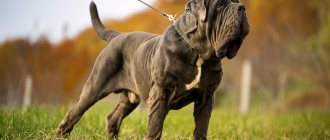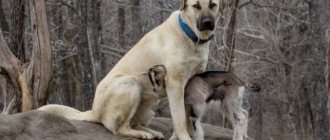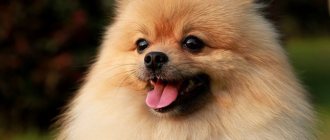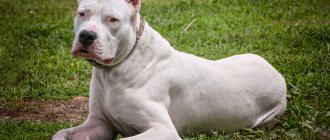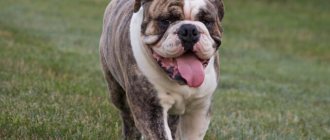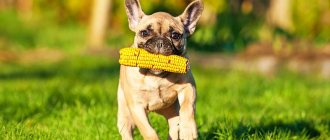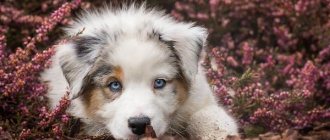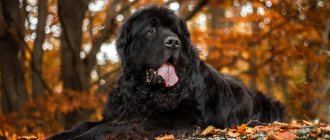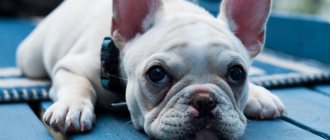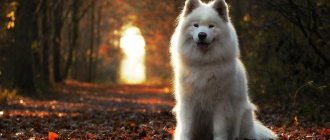The Belgian Shepherd is a dog that is popular all over the world. One of the varieties is the Malinois. This is an elegant, strong and hardy dog that is in demand in the police, security, Ministry of Emergency Situations, and the army. Thanks to their high intelligence and independence, these dogs help search for prohibited substances and missing people. They are loyal, affectionate, but suspicious and vigilant guards. Parenting needs to be taken seriously; not everyone can handle it. Therefore, before getting this breed, you need to study the features, pros and cons, as well as reviews from the owners.
- Varieties
- Head and muzzle
- Training and education of Malinois
- How to feed a Malinois
Breed characteristics
| Short description | |
| Origin: | Belgium |
| Conditions of detention: | In a house without a garden, in a house with a plot, in an apartment (with regular walking) |
| Purpose: | Guard dog, companion dog, herding dog |
| Color: | Redhead with charcoal and black mask |
| Wool length: | Short |
| Adult dog size: | The height of females is 56-62 cm, males 60-62 cm, weight of males is approximately 25-30 kg, females - 20-25 kg |
| Average life expectancy: | 10-14 years |
| Walk: | Mandatory walk 2-3 times a day |
| Physical activity needs: | High physical activity needs (regular or daily exercise for more than 3 hours per day) |
| Fédération Cynologique Internationale (FIC) classification: | Group 1: herding and cattle dogs, Section 1: shepherd dogs |
| Puppy price: | From 15,000 to 40,000 rubles |
Nutrition
As is the case with other breeds, Malinois puppies eat about 5-6 times a day. At three to four months, the number of servings is reduced by one per day, by six months the dog eats three times a day, and by one year of age - twice a day.
Malinois puppy
However, some breeders claim that already at six months the dog can eat only in the morning and evening. However, in practice this is not always the case. And don’t forget about the principle: reducing the number of meals means increasing the contents in the bowl.
You can easily find weight and height charts for dogs of this breed on the Internet. If the owner is worried that his dog is malnourished, he can use the data on the sign. Although usually the story is the opposite with Malinois, since the dog has a tendency to become obese.
Basic principles of eating:
- gradual weaning from the food that the breeder gave the dog;
- gradual introduction of new products into the diet if the dog is naturally fed;
- exact adherence to the feeding schedule on time;
- attention to the weight of portions;
- Regularly refreshing a bowl of clean drinking water.
Malinois boy age 3 years
There are three types of feeding, from which the owner will choose what suits him and the dog: natural, artificial (factory food), mixed. If everything is relatively clear with the mixed type, then the artificial type, which implies the use of dry food in the diet, must be of high quality. It is desirable if it is premium or extra-premium class.
Such food is not sold everywhere; for example, you rarely see it in a regular supermarket. But you can be sure that it will not harm the dog (Malinois is prone to allergies) and will be beneficial. The main advantage is saving time on cooking.
If the owner decides to cook for the pet himself every day, he will need to know the lists of allowed and prohibited foods. Many types of meat are allowed, such as beef, lamb, veal, poultry and even horse meat. You can boil it, you can crumble raw pieces into pieces, but you should avoid minced meat. Pork is prohibited due to its high fat content. Sea fish is also allowed as protein.
The preferred cereals are oatmeal, rice and buckwheat. The taste can be enhanced by cooking the porridge in rich meat broth. It is better to give vegetables locally, boiled or grated. Eggs are allowed a couple of times a week.
Allowed “fermented milk” includes natural yogurt, fermented baked milk, kefir and yogurt. The taboo list includes: river fish, garlic, onions, spices, baked goods and chocolate, spicy foods, salted and fried foods, sharp bones.
History of the origin of the species
There is a common myth about the Malinois's country of origin. Some dog experts believe that the homeland of this shepherd is France. In fact, this breed was developed in the Flemish region of Belgium (Malines or Mechelen), and the names of the provinces were written in French before the appearance of the German and Dutch dialects.
The ancestors of Belgian Shepherds can be considered short-haired ancient representatives of herding dogs living on the border of the country. Through simple selection, farmers developed 4 types of working dogs, whose abilities they boasted at exhibitions. In 1891, veterinarian Adolf Riyul noticed their similarity and made attempts to develop an ideal guard herding breed. The general physical qualities were the same, only the color differed, according to which 3 standards were determined in 1907:
- Medium length black coat - Groenendael;
- Ash gray long coat - Laekenois ;
- Red short coat – Malinois ;
- The fourth type known to us - Tervuren - was recognized much later.
The Malinois shepherd dog remains the most productive species at the moment. When breeding it, they did not pay much attention to appearance, but developed strength qualities. Other dogs were trained for exhibitions and podiums, so they practically lost their functions as guards.
National pride of Belgium
Until recently, there was controversy surrounding the origin of the Malinois breed: some dog experts believed that this breed was French, and some insisted that these dogs were bred in Belgium. The origin has become a matter of dispute due to the French spelling of the city of Malines (Mechelen - Dutch, Mecheln - Flemish, Malines - French) in the province of Antwerp. Dutch at that time was not yet used as an official language, and documents were filled out in French. Like any selective breed, a professional was behind the breeding of the Belgian Shepherd - veterinarian Adolf Riyul . Professor Riyul set himself the goal of showing the world a special breed, the national pride of Belgium - a dog with special characteristics. The choice for selection fell on herding dogs, which for decades served local residents and guarded their homes. In the process of breeding “national pride,” the breeder relied on the quality of the coat, selecting medium-sized dogs, but different in color and coat length. In 1892, the professor presented the Belgian Shepherd at an exhibition. 15 years later, cynologists, based on the species bred by Riyul, established three new standards for this breed with different colors and coat lengths: the Groenendael - semi-long-haired with black color, the Laekenois - gray-ash color with long hair, and, in fact, the Malinois - a dog endowed with short hair and dark brown or charcoal color.
Distinctive features
It differs from its fellow Malinois in its medium size and short hair. She is also not superior to others in speed and endurance, but is considered the most efficient. The standard height for a male at the withers is 60-66 cm , for a female - 56-64 cm . Dogs weigh no more than 30 kg due to their leanness.
Thanks to its good muscular physical shape, the Malinois appears proud and graceful. There are certain breed standards that must be checked before allowing an individual to reproduce:
- The head is proportional to the body, due to the muzzle it seems slightly elongated. The forehead is pronounced, smoothly turning into the bridge of the nose, the brow ridges do not protrude; rounded occipital bone.
- The muzzle is elongated, slightly narrowed towards the nose, giving the head a rectangular shape. Scissor bite (the upper jaw covers the lower jaw), the jaws are strong. The lips are thin, not saggy, and pigmented black. The nose is round and large. The cheeks are flat.
- eyes are not deep set. The color of the iris varies from dark brown to golden. The look is intelligent and wary.
- The ears are wide at the base and pointed at the ends. Directed upwards, docking is not accepted.
- The body is rectangular (more elongated in females), deep, narrow chest, elongated ribs. The loin is short and wide. The belly is lean. The tail is sickle-shaped, wide at the base, and not set high; The coat is short, without a tassel, but with elongation.
- The neck is muscular, wide, elongated and widens towards the shoulders. There is no suspension.
- The limbs are strong, well developed, muscular. The shoulder blades are long and slanting. The hind ones are more massive with wide hips. They move in the same plane as the front ones. The feet tend to be round in shape, with dense pads and hard nails.
- The coat is straight, hard, flat, short with a silky undercoat that helps the dog survive any weather conditions.
- Color red, fawn. There are charcoal markings on the sides and back, and a black mask on the face from lips to eyes.
The standard is considered generally accepted. Any deviations are defined as defective (both in appearance and behavior). Aggressive, lazy, stubborn dogs are excluded from further reproduction.
Interesting Facts
- Powerful legs allow the animal to overcome obstacles up to 2.5 meters high and up to 5 meters wide.
- Malinois are capable of performing complex and spectacular tricks. The dog can hold a glass of water on its head and at the same time avoid obstacles or climb stairs.
- Since 1974, the International Canine Association has banned the breeding of Malinois and other varieties of the Belgian Shepherd.
- Malinois dogs, together with members of American special forces, took part in the search for the refuge of Osama bin Laden.
- Malinois serve in the Russian Ministry of Emergency Situations. Animals search and rescue people.
- Dogs are used to guard the White House and other government buildings. Before the American President arrives at the new premises, it will be thoroughly examined by Belgian Shepherds for the presence of explosives.
- Malinois starred in the film "Tehran-43".
- Dogs took part in hostilities in the North Caucasus.
- Every year the International Belgian Shepherd Show is held in Paris. About 600 dogs from all over the world take part in it.
- French actor Alain Delon was a big fan of Belgian Shepherds.
Photo of an adult dog
REAL SHEPHERD DOG – MALINOS
It's impossible not to admire these dogs. In the speed and intensity of performing a given task, in learning ability, desire to work, unpretentiousness, endurance, and especially in the performance of defensive skills, it is difficult for them to find equals.
Originally from Belgium, today they have gained the status of the most sought-after breed throughout the world for work in the army and police.
Malinois are leaders in all world systems of protective dog sports. Behind these remarkable achievements of the breed is more than a century-old culture of working breeding by breeders in Belgium, Holland and France. It is to the traditions of working Malinois breeding that I want to dedicate my story about this breed.
ORIGINS OF THE BREED
In Belgium, the first service use of dogs dates back to the beginning of the 18th century, when dogs began to be used to help the city guard. These animals had not yet been specially trained; they simply accompanied the guards on patrol of the city streets. In the 18th and until the end of the 19th centuries, dogs were actively used for herding sheep, as well as for guarding on small farms. The dogs differed in size: at the top they could be the size of a wolf, at the bottom they could be as tall as a fox, but they were all quite lightly built, very fast and smart.
By the end of the 19th century, many thousands of such dogs, similar in appearance and character, could be observed in Belgium, Holland, and northern France. They were also distinguished by their devotion to their master and distrust of strangers. The dogs were well adapted to the local climate, in which both wind and rain were constant. But the main thing is that all these animals were workers who performed certain functions, and among their owners, most of whom were simple farmers, there were no people who attached great importance to the exterior or were keen on dog shows, which were already fashionable at that time.
However, back in the 1880s, those owners who became interested in training began to publicly demonstrate the remarkable abilities of their Belgian Shepherds. For these simple farmers and townspeople, it was a way to make money, a pure business - to attract as many people as possible to a specially fenced and equipped platform for the performance (ring), and to receive an entrance fee from them. At such performances, the dog, at the command of the owner, overcame various kinds of obstacles (barriers, suspension bridges, hay bales, ditches with water, high booms, etc.) and obstacles that were placed in front of the dog by an assistant dressed in a protective suit. This is how the Belgian Ring was born.
Ring's "father" is considered to be a talented and enterprising Belgian named Edmond Moecheron. Thanks to his talent as a trainer and entrepreneur, he quickly became a celebrity, his demonstrations attracting large crowds of curious people. Mocheron, his assistant and their three Belgian Shepherds (Dax, Nick and Miss) were welcome guests at racetracks, cycling events, circuses and fairs of all kinds. Newspapers wrote sensational articles about them, other people began to repeat their acts, and performances with trained dogs quickly became an integral part of any public festivities.
BELGIAN SHEPHERD DOGS - THE WORLD'S FIRST POLICE DOGS
Mocheron and those who followed his example showed their “rings” in Belgium, France and Holland. One of these performances was seen by Mr. E. Van Wezemael, Chief Commissioner of the Belgian city of Ghent.
The commissioner was faced with the task of combating growing crime in the face of a shortage of personnel and with the reluctance of the city fathers to allocate funds for additional personnel. Van Wasemael was able to appreciate the abilities of Belgian Shepherds and their trainers and realized the benefits that could be gained from using Belgian Shepherds in the police force. It was he who came up with the idea to include a dog in the patrol, trained to bite and detain the offender. The results were not long in coming - criminals began to leave the city, in every possible way avoiding clashes with the police and their dogs.
Having received support from the city fathers of Ghent, Van Wasemael officially formed the world's first police dog squad, the Gent Hondenbrigade (Ghent Dog Brigade), in March 1899. That same year, Van Wasemael opened the world's first police dog school, and later even wrote a book about the use of dogs in the police. The book aroused great interest among specialists in many countries. Switzerland, Finland, Serbia, Russia, France, Monaco, Italy, Holland, England, the USA and even Brazil corresponded with Van Wasemael, interested in Belgian Shepherds, their selection, training and use, and also sent people to study the training methods used and purchase trained ones dogs.
In Belgium, Holland and France, interest in these wonderful dogs grew everywhere; enthusiasts formed clubs and sought official recognition for their dogs. By 1891, quite different types of dogs were divided into breeds and varieties, and breed groups such as the Dutch and Belgian Shepherds appeared. Among the Belgian Shepherds, several varieties began to be distinguished (initially there were eight, and today four are officially recognized). Groenendaels were called long-haired black dogs, Laekenois were dogs with curly hair, Tervurens were all other long-haired dogs, and short-haired shepherd dogs were called Malinois, in honor of the town of Mechelen/Malines in Belgium. In this town there were many people who were seriously interested in training their dogs, and the first club for lovers of the short-haired variety appeared here.
Malinois have never been popular in shows, they are almost always kept only for work - performing herding and protective functions. The vast majority of breeders of the breed bred them only for work, and accordingly, selection was carried out only for qualities needed for work. From the earliest days of the breed's existence, rings helped with this task.
The fate of the other three Malinois brothers was different. Coming from the same heterogeneous mass of herding and farm dogs and possessing the same talents as the Malinois, thanks to their spectacular appearance, they quickly became the property of European show rings, and as a result, simply a decoration of many homes. Those who were engaged in breeding dogs to satisfy the needs of show rings and ordinary people did not put selection for working qualities at the forefront and, of course, had no idea about the specifics of police, shepherd and protective work. As a result, today neither Groenendaels, nor Laekenois, nor Tervurens, unfortunately, can be classified as working breeds.
BORN OF RINGS
The history of the formation of the Mechelaar (Flemish), or Malinois (French, Walloon dialect) breed is inextricably linked with the formation and development of the Belgian Ring - the world's oldest protective dog discipline. In 1903, the first Ring competitions took place in the city of Mechelen (Malin). At that time, the testing program was not yet clearly defined, but each team tried to show the best that their dogs could do.
In those years, competitions included:
- Moving next to the owner on a leash;
- Importation of the item specified by the owner;
- Protection of the owner's belongings in his absence;
- Jump over an obstacle (up to 2.85 meters);
- Jump over a hole or channel (up to 5 meters);
- Owner protection;
- Attack of assistants pointed at by the owner;
- Retrieving an object specified by the owner from the water.
The first official rules of the Belgian Ring were approved in 1908 and remain virtually unchanged to this day. However, since then, many important events have occurred for the development of the discipline itself: the very first club, founded in 1913 and overseeing the first ring competitions, actually ceased to exist.
Systematic competitions and championships in the Belgian Ring began to be held under the auspices of the oldest and one of the most influential Kennel Clubs in Europe - the Royal Society of Saint-Hubert (SRSH) in 1926. Since then, with two exceptions (in 1929, when a Malinois shared first place with a Groenendael, and in 1952, when a long-haired offspring of two Malinois, registered as a Tervuren, took first place), only Malinois have received the title of Belgian Ring Champion. The best results for other breeds were second place for the German Shepherd in 1935 and second place for the Bouvier des Flanders in 1952.
The Belgians themselves explain this fact by the strict demands of their standards on the flexibility of the nervous system, endurance, and especially on the health of the musculoskeletal system of dogs. The well-known Belgian Rottweiler breeder and a big fan of the Belgian ring, Guy Verschatse, writes this in his article dedicated to working Rottweilers: “The Belgians do not need photographs of the hip and elbow joints, since Malinois breeders believe that if a dog can overcome the barrier of two every day more than a meter and a ditch of more than four meters for many years, then the dogs have good joints. Such conclusions have a basis, because when we compare the Malinois population with the population of German shepherds or Rottweilers, selected using kerungs and all kinds of checks, the difference is obvious. We see that we have lost the working qualities of our breeds, and this makes us think. Today, trainers are trying in vain to find suitable candidates for the big sport, and police officers everywhere prefer not a German shepherd or a Rottweiler, but a Malinois. Perhaps we have forgotten what is important and what is not.”
Puppies begin training in the Belgian Ring at 6 weeks. The next two to three years are painstaking daily work until the dog is ready to participate in competitions at the initial (Cat.3) level. Further, only about 5% of all males who started training reach the highest level competitions (Cat.1) (traditionally, females are not used for the Belgian Ring!). But there are not isolated cases when the Belgian championships were won by 11 and 12 year old males, who were still mating and producing offspring, even at this age. This approach is beneficial for the breed in that it involves very strict culling of sires.
In the early 1960s, in connection with the initiative of the FCI to take over the Belgian Ring, some members of the SRSH began to put forward proposals to somewhat soften the severity of judging and simplify the rules. This was motivated by the need for greater accessibility of the ring for other breeds. As a result, those who felt that the requirements would become too lenient and the judging too insufficiently strict and, fearing that the changes would immediately affect the quality of their invaluable Malinois, left the Royal Society of St. Hubert and organized an alternative organization - the Nationaal Verbond der Belgische Kynologen (NVBK). They were not stopped even by the fact that the dogs of this national club were denied official FCI pedigrees. They lost the opportunity to sell their puppies with pedigrees to this organization, but retained the excellent working qualities of their dogs. So the Belgian ring was divided into two versions - NVBK (National Union of Belgian Cynologists) and Saint Hubertus, which received the patronage of the FCI.
All the exercises listed in the very first rules are one way or another present in modern competitions in both versions, but the working quality of the livestock of those who train and breed Malinois in NVBK today is incomparably higher. In Belgium, France and Holland, Malinois blood from NVBK is still illegally transferred to lines closed in the FCI system. The main sires in many of the best Malinois lines, as well as many of the Malinois leading in all types of protective dog sports in the FCI system, are direct descendants of NVBK champions and their sons.
It is thanks to the Belgian Ring and two very similar disciplines in neighboring France and Holland, as well as thanks to people who were dedicated to the tradition of selecting the strongest dogs in protection work as sires, that the Malinois has become what it is - the No. 1 working dog around the world .
In Holland, at the beginning of the twentieth century, thanks to the efforts of dedicated enthusiasts, a standard for the training of police dogs was developed within the framework of an officially recognized organization - the Association of the Royal Dutch Police Service (KNPV - Koninklijke Nederlandse Politiehond Vereniging). Without a KNPV certificate (KNPV celebrated its centenary in 2007), a dog cannot be accepted into service in the country's government agencies. During its existence, the standard has hardly changed and differs little from the original. Today the KNPV has approximately 10,000 members. Every year, about 1,000 dogs are certified for police and army services of various profiles, about half of which are immediately purchased by law enforcement agencies of different countries.
In KNPV, as before the official division of the breeds, sometimes matings of Mechelars/Malinois are carried out with Dutch Shepherds (Dutch Shepherd, Hollandese Herder), less often with German Shepherds or Bouviers des Flandres. This allows mechelars, with very close regular inbreeding (I-II, II-II, I-III, II-III, etc.) over many generations in different lines, to steadily consolidate valuable sets of working qualities, while avoiding inbreeding depression and loss of genetic diversity. There are no official rules for this: as in the Belgian ring, only males who have shown outstanding performance are used for breeding with females - descendants of the same outstanding males. KNPV as an organization deals only with the certification of dogs for use in the army and police and does not issue official pedigrees, although the Dutch know the origin of their shepherd dogs thoroughly and value their lines, proud of the rigidity of the hundred-year-old KNPV selection.
At the same time, France has its own ring discipline - the French Ring, in which Malinois have long fought for the dominant positions with German shepherds and their long-haired brothers - Tervurens and Groenendaels. In the late 70s of the last century, the trend of breeding show dogs and companion dogs prevailed in these breeds. This has led to the loss of working qualities in the main stock of these breeds and no longer allows them to seriously compete with the Malinois. As a consequence, since 1980, only Malinois have won the French Ring Championships.
In order to achieve success in the ring, you need a dog with a great desire to work, as the French themselves put it, “with a love of fighting,” extremely hardy and healthy. An experienced and knowledgeable coach is equally important. After all, for example, at the third level in the French ring, the dog must work on the field for forty minutes, or even an hour, without breaks, performing obedience skills, a very complex jumping system, and then defense. Jumping is overcoming obstacles with a height of 2.30 meters from a place (previously the height of the obstacle reached 2.70 m, but at the request of the French German Shepherd Club, the requirements were at one time reduced to 2.30 m) and long jumping - 4.50 meters.
The Rules of the Ring are a document of about 300 pages, and the right to serve as an apache (figure) in the main competitions (qualifiers and the French Cup) is an honor that figures achieve through many years of practice and passing a very strict certification. Many of the most famous producers in the French Malinois lines, starting to compete at 3-4 years of age, annually won the right to participate in qualifying and national championships up to the age of 10!
In the mid-80s of the last century, Malinois also came to the original German type of protective sport, originally created as one of the conditions for admission to breeding of German shepherds - Schutzhund (protective dog, German). From 1986 to 2007 in Germany, according to the DHV, the annual all-breed Schutzhund Championships were won by Malinois 15 times, the national all-breed German Schutzhund Championships under the auspices of the VDH club since 1998 - only by Malinois. In the annual international competitions among all breeds in the IPO (FCI), in 8 of the 16 championships held so far, Malinois have won, and since 1998, only Malinois have won first places.
ON THE QUESTION ABOUT BREEDING MALINOS
Today, Malinois are unique among other working breeds in that in breeding the selection of sires is carried out exclusively on working qualities. Here are some of these qualities:
-strength of the nervous system;
- speed, intensity of work;
-desire to fight, desire to dominate an opponent in a duel;
-effective, firm grip;
- endurance, resistance to stress and strain (meaning serious, regular, day after day, year after year, physical and psychological stress);
-health, durability in use, unpretentiousness;
-learnability, contact, manageability, desire to work for a person and with him.
These qualities can be identified and tested ONLY through continuous work with the dog, testing it in a variety of situations. Only in this way can the ability of each dog of this breed be revealed to meet the high standards to which each manufacturer in the Malinois breed is required by its purpose. The laws of genetics are such that selection, which is carried out with any other bias, quickly leads to the loss of the breed’s working qualities, and as a result, to the degradation of the breed as a working breed. There are dozens of sad examples of this. In other breeds, the approach to the selection of breeding sires has been dictated for decades by show breeding with an expert assessment of the exterior of dogs moving in the ring, and the social demand for a dog that is comfortable in everyday life - a pet with weakly expressed instincts, undemanding to stress.
This is how working breeds disappear; due to the departure from the principles of selection strictly for working qualities, the genetic pool of valuable working qualities is becoming smaller. Therefore, today it is difficult to find a good German Shepherd, Giant Schnauzer, Rottweiler or Doberman for serious work in the police, army or special services, where not only “biting and sniffing” dogs are needed, but also healthy, hardy and durable dogs. Unfortunately, the vast majority of modern dogs of the above breeds (at least 90% of the total population) today are not working breeding stock.
ON THE QUESTION OF WORKING BREEDING
Considering the specifics of the post-DOSAAF mentality, as well as the lack of a working breeding culture in Russia and Ukraine, we often have to deal with a misunderstanding of the specifics of working breeding in general, and Malinois breeding in particular. Once on one of the Russian-language forums I was asked the following question:
“Alex Vyatkin!
Hello, I want to make a reservation right away so that later no one will have the desire (when getting personal) to shower me with reproaches, I am an amateur. And accordingly, my questions are from the amateurish category. As far as I could judge, you put the working qualities of the breed at the forefront and do not recognize show classes, and, accordingly, breed exhibitions, where representatives of the breed that are closest to the breed standard are evaluated (correct me if I’m wrong), but then explain to me, please, how do you even select puppies?”
I present the answer in full, since in the light of introducing the breed to a wide range of readers of the magazine “You and the Dog” it is also relevant:
“Hello, I assume that the concepts of “breed” and its degree, as well as “compliance with the standard,” are perceived here as an invariable privilege of shows and exhibitions. The word “standard” apparently implies some kind of official document of a certain organization (in this case, FCI standard No. 15), proclaiming the “ideal” sought by everyone, designed to be demonstrated in the conditions of FCI shows and exhibitions. In accordance with this "ideal"
a qualified (according to the concepts of the same organization) expert, in the conditions (again) of shows and exhibitions, evaluates the “quality” of the presented dog and the degree of its value for breeding. That is, shows and exhibitions are perceived as mandatory zootechnical events and are an integral system for selecting sires in the breed; they are part of working with the breed.
Dear readers, NOW TRY TO IMAGINE that there is a world of people who deal with dogs within the framework of a long-standing, centuries-old culture, with traditions and attitudes towards animals that are NOT AT ALL consistent with the above-mentioned approach. A world in which the entire system of value and evaluation of dogs as producers has (and never has) anything to do with the above scheme; a world that is based on completely different approaches to the reproduction of Quality and concepts of Beauty.
People from this world will find it difficult to answer you whether “this dog in the photo” corresponds to the breed and whether it is good until they see it at work for its intended purpose, do not appreciate its desire to work, to fight the violator (and further on a long list) so that say with confidence: “Yes! “I like it, it’s a good Malinois.”
They do not understand and do not accept the opportunity to evaluate the quality and degree of value of an animal for breeding OUTSIDE of demonstrating its suitability for its main function - the work of a police, army, or protective dog.
If you ask them if they like a dog, they will immediately talk about its grip, endurance, athleticism, its ability to work in tandem with a person, its dominance in protective work, and how these qualities are possessed by the dog’s relatives - ancestors and descendants... They will base their assessments on those qualities that are not important for breeding Malinois in the FCI, AKC, RKF, British KC, KSU, etc. system.
For true Malinois breeders of working lines, the very concept that, for breeding purposes, the degree of conformity of an animal to the breed can be assessed without seeing its work, without knowing its ancestors and without testing the dog to work with the maximum demands, and, whenever possible, in competition among the best of the breed, is unacceptable. the best carriers of the required quality of work.
In the world of these people, competent breeders understand working qualities to a fine degree, are well aware of the degree of their manifestation in lines and how these lines are combined with each other, which of the sought-after qualities are most persistently passed on by inheritance. Without such experience and such knowledge, it is impossible to obtain Quality and Beauty in the understanding of these breeders.
It is these people who are credited with creating and reproducing those Malinois that brought the breed world leadership in all protective sports; they created dogs with those qualities that distinguish the Malinois as a breed today from all other breeds, and which make it the most in demand in the world's government agencies.
The concept of “standard as a degree of approximation to the ideal” in relation to a dog standing or moving in the show ring does not exist for them.
If an animal does not work like its ancestors, and in accordance with traditions and requirements, it does not exist as a representative of the BREED and has no right to continue it, no matter what the “expert” from the “club” says about the dog’s suitability for other purposes. “standard”, examining dogs simply moving in a circle in the ring.
For the bearers of the working breeding culture, “standard” is not some kind of ideal (true Malinois connoisseurs know that there are no ideal dogs), but rather a high degree of expression of the characteristics that I have already listed several times. For them, it is the ability to work that separates their breed from all others, and makes their Malinois what it is - the best working breed in the world.
None of the Malinois breeders whose dogs have proven themselves to be worthy of work in the army, police and protective sports (and, equally, dogs most suitable for working with livestock, arctic long-distance running, etc.) go to the ring for an opinion expert: “Look at my dog - is it suitable and to what extent to participate in the breeding of dogs for the needs of the army police and protective sports?” Dot!
As a result of this approach to breeding, the number of puppies in litters of working lines suitable for service and protective sports is 70-80%. In the homeland of the Malinois in Belgium, as well as in countries where Malinois have been used in the army and police since the beginning of the last century (in France and Holland), 90-95% of breeders breed Malinois of only working lines. These dogs, as well as their descendants of relatively young German breeding, confirm their quality by topping the lists of leaders in all international protective sports, where access is open to all breeds. Such successes today, alas, do not exist in any other service breed.
Experience shows that people with other rules and traditions DO NOT HAVE THE SAME dogs. Without a culture of working Malinois breeding, they will NEVER be able to get such dogs. If you, looking at real Malinois with a capital “M”, can imagine the right of their creators to define Quality and Beauty, abstracting from everything that they knew and took for granted before, then you will understand me.
I really hope for it.
ALEX VYATKIN
Vyatkins' Malinois
Photos of puppies
Choosing a puppy and its cost
The price of one puppy varies from 400 to 1000 euros. It all depends on the dog's pedigree. If the puppy’s ancestors had championship titles, then the cost of such a shepherd dog increases significantly.
You can buy puppies at foster homes, where the dog will immediately receive the necessary vaccinations.
Breeders recommend adopting a puppy at the age of 10-16 months. Bitches are more affectionate and flexible, and cables look impressive, and they are independent in character.
Features of character and behavior
- Malinois, like all shepherd dogs, are very smart , not prone to aggressiveness and are easy to train, despite some independence.
- Puppies of this breed are active, curious and playful. The breeder should remove all dangerous objects, wires and office supplies in advance, and close all passages and manholes.
- It is not recommended to own Shepherd dogs if you have insufficient experience in raising dogs. Malinois need training and constant attention from the owner. Lack of training will lead to a change in the pet’s docile nature: it will become independent and uncontrollable.
Most often, representatives of this breed are serious and friendly towards people they know. But, seeing a stranger on their territory, they will adamantly fulfill the duties of a security guard.
Advantages
- Genetically, Belgian Shepherds were bred to guard sheep and other livestock. Therefore, the most important quality for them is observation. These dogs take their work very seriously, are helpful and devoted to their owner, and follow all his orders.
- Malinois are highly intelligent. They understand at a glance, thanks to this they are amenable to training and education. Quite patient, but cannot stand rudeness.
- These dogs have huge hearts. They will become a loyal friend and family member, accompany you on a hike, a trip, and will be a good running partner. The attitude towards children is ambiguous, rather positive, but dog experts do not advise leaving such serious large pets alone with babies.
- Hardy . They tolerate both heat and cold and do not need a lot of drinking or feeding. Developed sense organs allow one to notice danger from afar.
- Positive qualities allow the “Belgians” to work in many law enforcement agencies: the Ministry of Emergency Situations, the police, military organizations, customs garrisons. Dog handlers believe that the Malinois is more suitable for service than the German Shepherd. She needs food and sleep less, is not so spoiled and is more resilient.
Flaws
- The breed has few disadvantages . They absolutely cannot stand loneliness and need constant attention and care. In such conditions, the dog withers, loses activity and adequacy.
- Likewise, Malinois do not like enclosed spaces and require constant active walking . They need strict upbringing and daily training to properly develop their skeleton and character. Hyperactive, mischievous, love to dig and chew. They are unkind to other pets, especially relatives.
- They shed actively in autumn and spring . When kept in apartments, they shed all year round and must be brushed daily.
- Without proper upbringing, they become aggressive and disobedient. Absolutely not suitable for beginners.
Character of the Malinois dog
The difficult character of the Malinois depends entirely on the owner’s ability to raise dogs. They are ready to follow their owner everywhere and serve him 24 hours a day. They “read” thoughts, predict desires, instantly determine their mood by intonation and gestures.
However, nature has endowed them with an independent disposition, the ability to think and make decisions independently. If you don’t work with your pet and don’t direct your talents in the right direction, he will act in his own way and behave unpredictably.
The Malinois has highly developed territorial and protective instincts. They clearly distinguish between strangers and their own. The first includes family members, the second includes neighbors, guests, and strangers.
A trained dog does not show open aggression towards strangers, but watches warily from the sidelines. If he senses danger, he instantly comes to the defense of his owner and family.
Malinois are confidently trusted to guard the house and property. She will not let intruders through. However, it is a mistake to have a dog just for protection. Without a job, a Belgian Shepherd cannot live normally.
The Malinois needs physical activity and mental tasks like air. Without them, she suffers, becomes nervous and aggressive. Directs excess energy to household objects, animals and people.
The Belgian Shepherd is reluctant to share its territory with other animals. Problems do not arise when pets grow up close together from childhood. An adult Malinois treats a same-sex dog with hostility, as if it were a rival. Cats, rabbits and hamsters can become hunted.
On topic: Choose a name for your puppy using a nickname generator.
Malinois and children
For a normal life together between a Belgian Shepherd and a child, two conditions are needed:
- The puppy grows up next to the baby from childhood.
- The dog is taught to respect the younger family member.
The Malinois gets along well with children over 10 years of age who can communicate with pets. He has mixed feelings about children. She is not suitable for the role of a patient nanny who will meekly endure inept treatment. Malinois do not like being treated like a toy, having their tail pulled, or being hugged.
A trained dog takes the baby under its wing, “shepherds” it, and protects it.
With a lack of upbringing, the animal tries to dominate the child. There are known cases of bites when trying to take away food or a toy from a dog that it considers to be its own.
Before bringing a Malinois into a family with a preschooler, it is better to spend time training the pet under the guidance of a dog handler who understands the breed.
A child under 5 years old should not be left unattended with a dog. An active, energetic pet may accidentally push the baby.
About raising a puppy and training
Malinois need socialization during puppyhood and adolescence. While it is possible to catch up later with dogs of other breeds, it will not be possible to retrain a mature Malinois. The puppy turns into an unpredictable animal that rushes at passing cars and passers-by, and is willful at home.
Stereotypes of future behavior are formed from 2.5 to 7 months. At this time, nerve cells intensively mature and conditioned reflex connections are formed. Good and bad habits acquired during this period remain for life.
From the first days, contact is established with the pet. They spare no time in playing together and teaching basic commands in a playful way. This is the only way to become a friend and authority for a dog.
After routine vaccinations, the puppy is gradually introduced to the world outside the home. They are taught not to be afraid of crowds of people, transport, and not to get lost in unfamiliar places.
From early childhood, they are introduced to other dogs and new people. If the owner behaves confidently and calmly in difficult situations for the puppy, then the pet will copy the behavior of the person. He will grow into a balanced, obedient dog.
Malinois are easy to learn, train quickly, and remember more than 100 commands. For normal physical and mental health, they work with him for at least 2 hours a day.
The dog perceives training as work. Quickly masters the general obedience course. He quickly gets bored with monotonous exercises and has to constantly complicate them.
The best option is to play sports. It doesn’t matter what type, the main thing is to constantly provide stress to the pet’s body and brain. He will feel needed and will not get bored with nothing to do. Malinois does not tolerate shouting or physical punishment. Rough handling makes the dog nervous and aggressive.
See also: Large review of medium-sized smooth-haired dogs.
Care and maintenance
- Like all medium and large dogs, the Malinois needs to run at least 6-7 km per day for proper bone development. It is important for them to interact with other people and pets in order to develop tolerance towards strangers.
- There is practically no smell from these dogs, but you can treat the premises with special solutions that can be purchased at any pet store.
- It is important to regularly vaccinate your pet and carry out deworming procedures.
- In addition, it is necessary to examine the eyes and ears and wipe them daily with a damp swab; brush teeth as they become dirty (give special cords for chewing and removing tartar), trim nails once every 2-3 weeks with special scissors. In the summer, it is important to treat your pet for fleas and ticks: drip medications onto the withers, put on collars.
Nutrition
Good quality nutrition for Malinois is the key to a strong skeleton and beautiful coat. The breeder can choose dry food, in which case it is necessary to buy only premium class. Cheap bait destroys the walls of the dog’s stomach and negatively affects the liver.
A natural diet must contain proteins, fats and complex carbohydrates, which are contained in:
- Meat (chicken, beef, turkey, rabbit);
- River and sea fish (boiled only);
- Vegetables and fruits (raw and boiled);
- Cereals, cereals, porridges;
- Eggs.
It is necessary to remember about the vitamin complex, especially in puppyhood. The dog needs calcium, fluoride and other useful elements, which it may not receive enough from food. Do not mix dry food and natural food to avoid upset and diarrhea for your pet.
Portions should be standard, calculated according to the formula 20% of the animal’s weight. Adult shepherd dogs are fed 2 times a day, puppies - from 3 to 4 times.
Health
There are no genetic diseases in Belgian Shepherds. From birth they are endowed with strong immunity and health. They live a long time for large dogs - 10-14 years. But even despite this, your pet needs to be vaccinated regularly.
Due to its mobility, Malinois often injure their paws, muscles, and ligaments. In such cases, you cannot leave everything to chance, but it is important to contact specialists.
Vaccinations
Vaccination of a puppy is an important procedure at the very beginning of life. It is necessary to develop immunity to certain diseases. As a rule, vaccinations are the same for all breeds.
- The first is complex (mumps, leptospirosis, enteritis, plague, salmonellosis, influenza). It is given to the pet at 1.5 months, then at 2, 7, 12 and annually.
- The second and very important one is rabies vaccination. Must be vaccinated at 6 months and every year thereafter. Without this drug, you cannot take your pet abroad.
Each vaccination is included in the puppy’s veterinary passport. The specialist must affix medication labels, stamp and date. You cannot vaccinate your pet yourself.
Two weeks before vaccination, the dog must be given anthelmintic tablets. Afterwards you cannot bathe or walk the puppy for 14 days. It is important not to allow contact with other animals, because the immune system is weakened.
Diseases
The following diseases can be considered hereditary, from parents to puppy:
- Thyroid disorders (successfully treated);
- Allergies (to pollen, food);
- Eye diseases (cataracts, retinal deformations, blindness).
Some health problems may be acquired. The reasons are poor diet and lack of exercise. So the dog can develop joint dysplasia (production of low-quality cells and deformation of the limbs), gastric volvulus (pronounced by bloating, surgical intervention is necessary), epilepsy (uncontrollable seizures).
Another cause of pathologies is pet obesity. Because of this, Malinois develops heart failure and psychological disorders.
Walk
An active lifestyle for the Belgian Shepherd is the key to good mood and well-being. When kept in a closed area (apartment, house without a garden, enclosure), it is necessary to walk the dog 2-3 times a day for 2-3 hours . Training should be regular. You need to stress your pet not only physically. Malinois perform well in agility (obstacle course), various games like Frisbee, they need to be given exercises to develop mental abilities: searching for objects, training commands.
Malinois puppies are curious and playful. They constantly need to pay attention, monitor their activities and pranks. It is worth remembering that the Belgian Shepherd is not a chain dog. Life “on a leash” is not suitable for them.
Grooming
Even though Malinois are short-haired, they require some care. First of all, you need to brush your dog 2-4 times a week, and daily during active shedding.
You cannot bathe shepherd dogs often; 3-4 times a year using special shampoos is enough. If you wash your pets regularly, their fur and undercoat will deteriorate.
Dermatitis under a thick cover is practically invisible and develops without any special symptoms. Therefore, it is very important to maintain a grooming routine and monitor your dog’s behavior.
Health
The Malinois is considered a naturally healthy dog. The average life expectancy is 12-14 years. There is a predisposition to certain diseases among representatives of the breed, but many problems can be avoided with proper care, feeding, and timely vaccination. It is also important to conduct regular preventive examinations at a veterinary clinic and treatment for parasites.
No matter how well you take care of your pet, some diseases cannot be prevented. The owner should know what health problems are most common in Malinois:
- Cataracts are an eye disease that can lead to vision loss.
- Joint dysplasia is characterized by severe pain and requires surgical intervention in the acute stage.
- Allergy - you need to detect the allergen and eliminate it. The allergen may be food or animal care products.
- Epilepsy – leads to convulsions, involuntary bowel movements. The disease can and should be controlled.
- Gastric volvulus is a serious condition and surgery is needed to save the animal.
- Obesity - occurs from poor nutrition and lack of exercise. Leads to metabolic disorders and other health problems.
It is important to ensure that the Malinois does not get injured. This dog is very active; he can get injured while jogging, jumping and other physical activities.
Mating
Mating a Malinois is no different from breeding other breeds. Cables become fully mature by 1.5-2 years of age , in females by 18 months . Mating should occur on 15-20th day of estrus. Before mating, you need to remember a few points:
- It is necessary to walk the individuals together in a free area; if the act occurs during a walk, the dogs should not be disturbed;
- After this, the bitch is taken to the dog so that he can feel comfortable;
- During the process itself, pets need to be helped (held, placed, placed with pillows).
Before mating, it is imperative to make sure that both dogs are healthy, vaccinated and meet the standards.
Training and education
The main thing to remember when training a BO is that it is an active, intelligent and quite original dog. She will not submit to a weak-willed, compliant person who has no experience in keeping dogs.
It is better not to engage in amateur activities when it comes to BO. The training process must be supervised by a dog handler, so it is necessary to begin taking OKD courses from 5–6 months. All Belgians can undergo ZKS after OKD. This is very useful for them, since, in addition to shepherding, BOs also perform service activities.
It is necessary to demand unquestioning obedience from the BO
During the course, the dog will receive another important aspect of BO education: socialization. Without it, even a good-natured Groenendael can become an aggressor. BO must know that the owner is an unquestioned authority. It is necessary to achieve from the dog unbreakable eye contact (that is, to constantly keep the dog’s attention on the owner), unquestioning obedience to the first command, but not by force, but by cunning: forceful coercion is unacceptable for BOs, since otherwise they close themselves off from the person.
When it comes to learning ability, Belgians can easily compare with German Shepherds. It is more difficult to train them only for the reason that BOs are often stubborn and show character.
Discipline is very important for raising BO
At home and on walks, the dog also needs to be taught discipline. She should not eat from the same table with people, and should not growl at household members, strangers and animals. Also, the BO must strictly know her place, not jump on forbidden sofas and armchairs, and not sleep with the owners in the same bed. Only then will the Belgian be able to grow up to be an obedient dog with whom it is comfortable to coexist.
Key points in training
Only an emotionally balanced person with a strong character and an iron will can raise a pet. Although Malinois are not prone to dominance, they need a firm hand. The collar should be spacious; a collar for greyhounds is perfect. Harsh punishments cannot be applied to them: hitting, swearing, shouting.
- The most effective method will be the “owner’s offense”; the shepherd will try to improve in order to change the owner’s mood.
- Agility and active games are perfect for training dexterity and reaction speed.
- Malinois also needs to be introduced to people and taken to public places. Such walks will help the dog adapt among strangers and develop obedience.
- Read about how to properly train a dog in the article: “Training a puppy: effective methods from dog handlers, learning commands at home.”
Attitude towards children and others
Speaking about the Malinois breed, experts pay attention to their clear distinction between those around them as “friends” and strangers. For the Belgian, the owner’s family is an object of protection. He will express his devotion and care to them in every possible way, and protect them from any danger. If a stranger appears in the immediate environment, the Malinois will have enough endurance to observe him from afar. However, at the slightest sign of aggression from an outsider, the shepherd will immediately rush into battle.
The same can be said about the dog’s desire to carry out the owner’s instructions. She especially loves the role of watchman. When guarding a plot or house, the Malinois will be a model of responsibility and conscientiousness.
Today, Belgian women are increasingly being bought into families for teenagers. And not in vain. They are wonderful friends, sociable and active partners. They will take part in games, show their sympathies, but will not forget about their main function: to protect the children of their owners from the slightest danger.
This breed of dog does not have much friendship with younger children. But they are indispensable assistants in supervision and protection from strangers. The dog will not harm the baby, but allowing itself to be pulled by the tail is beyond its strength.
How to choose a puppy
- If the choice fell on this particular breed, you need to choose a proven nursery with good reviews. Before purchasing, it is important to consult with the breeder: find out about the puppy’s nutrition, its weight, and living conditions. If possible, study the pedigree and breeding diseases. It is important to examine the parents themselves.
- In good nurseries, puppies are vaccinated and given passports and club cards. After viewing all the documents, you can take a look at the pets themselves. They should be clean with a shiny coat, active and curious.
- The cost of a dog directly depends on the parents and breeder. If this is an official breeding place, and all the pets there are champions, then the price of the puppy will be high - 30,000-40,000 rubles . If you decide to buy a Malinois “from hand”, you will pay much less, about 15,000-20,000 rubles . However, you will risk the health and character of the shepherd.
Any dog in the house is a family member and a loyal friend. The Belgian Malinois will become not only a pet and companion, but also a good guard and protector. She will happily accompany you wherever you go, and will be devoted and faithful with all her heart.
5 / 5 ( 1 voice )
Pros and cons of the breed
The breed is smart and quickly grasps the lessons presented to it. However, she gets tired of following the same commands for a long time. When this happens, the dog stops obeying and begins to play around. Therefore, the trainer is advised to alternate training with active games for dogs of the appropriate age. This will allow you to maintain interest in classes and quickly master the necessary skills.
In general, the Malinois is so energetic and active that it enjoys learning new commands and performing assigned tasks. She has an excellent memory and does not need long-term training in new training positions. What she remembers, the dog is ready to proudly demonstrate to the owner upon request.
But for the Belgian woman, the owner’s dissatisfaction with her work will be a real grief. You cannot scold her or make complaints in a rude manner. Touchiness is one of the characteristics of the breed.

